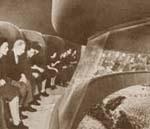 |
|
futurama, autogeddon |
|
Imagining the Superhighway from Bel Geddes to Ballard |
six: our dreams will come true
[16] The mysterious man and the dreaming woman end the film by driving onto the highway of tomorrow. Sitting in their futuristic car ("designed for the electronic highway of the future, the fabulous, turbine-powered, Firebird II!"), they prepare to head out, the man reporting to the "control tower" reminiscent of Bel Geddes' 1939 radio towers: "Firebird II to control tower, we are about to take off on the highway of tomorrow, stand by." As they speed onto the highway we see a starlit Jetsons-style scene showing model cars driving on a series of curved highways, and music swells as the woman sings:
The film suggests a fissure already forming in the 1950s with the saturation of mass consumerism: how to get women, an untapped market, to buy expensive products? The answer was to suggest that technology and automation would free them from drudgery -- but ironically this "freedom" meant freedom to continue being viewed as beautiful but useless ornamental objects. The car, in this case, was merely another consumer item, while the highways of the future suggested not the freedom of the road but the fulfillment of the sugary romance women were taught to desire. [17] The darker side of highway construction was well hidden. The Interstate was backed by the powerful members of the highway lobby, including not only car manufacturers and oil companies but also a vast number of smaller business organizations, such as "the Association of General Contractors ƒ the National Asphalt Pavement Association; the National Ready Mixed Concrete Association; the American Concrete Paving Association; and the American Road Builders Association" (Lewis 110). The 1952 movie "Key to Our Horizons" suggested that "any picture of America without automobiles is hopelessly out of date," and went on to show how two out of seven Americans owed their employment to the burgeoning automobile and road surfacing industries. [18] As the lobby gained power, it began releasing pro-highway films which seemed to address public concerns about the impact of the proposed Interstate system. "Highway Hearing," commissioned in 1956 by the Dow Chemical Company, featured a dramatized version of a town meeting between concerned citizens and highway officials. The film began with the opening of a new stretch of highway and flashed back to the meeting, which included irate citizens (mollified by officials' answers) and a "movie-within-a-movie", shown to the town citizens and featuring classic pro-automobile rhetoric. The citizens in the end agreed to vote for the highway and it was duly built; the last scenes returned to the grand opening with now-satisfied townspeople come along to celebrate. |
||
| 1 |
| 2 |
| 3 |
| 4 |
| 5 |
| 6 << |
| 7 |
| 8 |
| 9 |
| 10 |
| credits |
| rhizomes |
